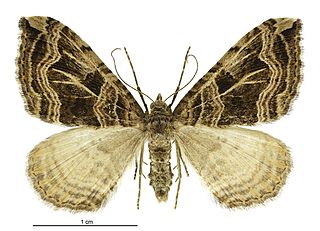
Xanthorhoe semifissata, commonly known as the barred pink looper, is a moth of the family Geometridae. It is endemic to New Zealand and is found throughout the country although it is much less common in the mountains in the south and west of the South Island. The larvae host plants include Nasturtium officinale as well as species in the Cardamine genus. Adult moths inhabit shrubs at the edge of native forest.

Tingena armigerella is a species of moth in the family Oecophoridae. T. armigerella is endemic to New Zealand where it is found in the North Island. The larvae of this species feed on plant litter. It is parasitised by the parasitic wasp Fustiserphus intrudens.
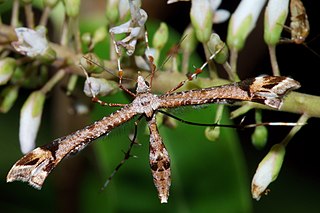
Amblyptilia falcatalis, the common Hebe plume moth, is a species of moth of the family Pterophoridae. This species was first described by Francis Walker and is endemic to New Zealand. This species can be found in both the North and South Islands. The larval host plants are in the Veronica genus and include Veronica stricta,Veronica salicifolia,Veronica elliptica, Veronica macrocarpa and Veronica speciosa. This moth likely has two broods a year and adults have been observed all year round.
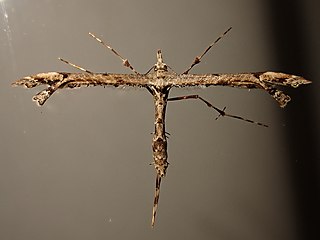
Amblyptilia repletalis is a moth of the family Pterophoridae. It is endemic to New Zealand and can be found throughout the country from North Cape to Bluff. The species inhabits a variety of habitats including native forest clearings, shrubland, coastal dunes and gardens. Larvae feed on the seed heads of Plantago plant species. Adults are on the wing all year round and are attracted to light.
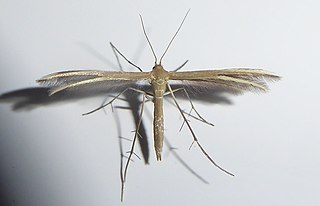
Pterophorus innotatalis is a moth of the family Pterophoridae. It is endemic to New Zealand and has been found in the North, South and Ruapuke Islands. Adults of this species have been recorded as being on the wing from October to March as well as in August and prefers to inhabit grass or fern covered hills. The larvae are leaf miners and feed on Dichondra species, including Dichondra brevifolia and Dichondra repens.
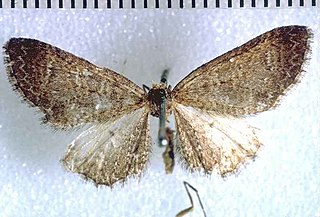
Pasiphila acompsa is a moth in the family Geometridae. It was described by Louis Beethoven Prout in 1927. It is endemic to New Zealand and has been observed in mountainous locations in both the North and South Islands. Larvae of this species have been reared on plants within the Veronica genus. Adults are on the wing from December to February.
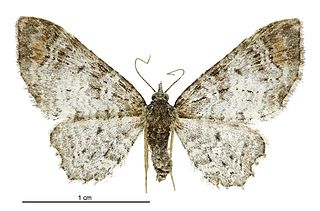
Pasiphila aristias is a species of moth in the family Geometridae. It was described by Edward Meyrick in 1897 and is endemic to New Zealand. This species is found in both the North and South Islands and inhabits subalpine and native forest. Adults are on the wing in December and January and are attracted to light.
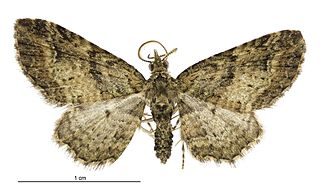
Pasiphila charybdis is a species of moth in the family Geometridae. It is endemic to New Zealand.

Pasiphila cotinaea is a species of moth in the family Geometridae. It is endemic to New Zealand. Its larvae feed off Olearia species and the adult moth can be seen on the wing from November to April. This species is regarded as rare.

Pasiphila muscosata, the emerald pug moth, is a moth in the family Geometridae. It is endemic to New Zealand and has been found in the North, South and Stewart Islands. The larvae of this species are known to be present in January and live on Muehlenbeckia species including Muehlenbeckia australis. The larvae tends to be brown but it is variable in both colour and markings. The larvae of this species pupates in a loose cocoon on the ground and adult moths emerge in September. Adults are commonly on the wing until the following May. Although adults tend to be a deep emerald green colour this species is again variable and there is also an orange-yellow variety as well as intermediate forms. Adults are attracted to light and often rest during the day on tree trunks.

Pasiphila plinthina is a moth in the family Geometridae. It is endemic to New Zealand and is found in both the North, South and Stewart Islands. It is on the wing mainly from June until September with occasional observations up to December, and is attracted to light. This species is similar in appearance to P. sandycias but can be distinguished from it as P. plinthina has palpi that are longer and has more blurred forewing markings.

Eudonia sabulosella is a species of moth in the family Crambidae. This species is endemic to New Zealand and is regarded as being common. The larvae of this species are known to damage pasture in New Zealand.

Asaphodes abrogata is a moth in the family Geometridae. It is endemic to New Zealand and can be found from the central North Island as well as the South Island. This species is inhabits open country at altitudes of between 2000 and 4000 ft. Larvae have been reared on Plantago species including Plantago coronopus. It has been recommended that Plantago raoulii be planted to attracted this species. Adults are on the wing in February and March.

Bityla defigurata is a moth of the family Noctuidae. It is endemic to New Zealand.

Asaphodes clarata is a species of moth in the family Geometridae. This species is endemic to New Zealand and has been found on the North and South Islands. The species inhabits open grassy areas, including tussock grasslands, in montane habitat. The larvae feed on the leaves of Ranunculus species. The adult moths are day flying and are on the wing from December to February and have been shown to pollinate Celmisia laricifolia and Hebe pinguifolia.

Physetica temperata is a species of moth of the family Noctuidae. It is endemic to New Zealand and found in the North Island and the top of the South Island in coastal areas. P. temperata is unlikely to be confused with other species in its range, even though it is not distinctively patterned. It is possible that males might be confused with males of P. homoscia but this latter species is much larger. P. temperata can be distinguished from P. caerulea as the former species has forewing veins that are marked black and a chequered forewing fringe. The adults of this species are on the wing from September to March. The life history of this species has not been well documented although it is thought that larval host species is Ozothamnus leptophyllus.
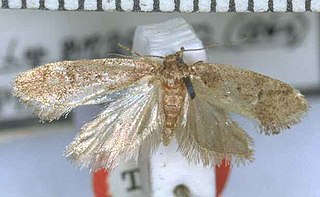
Tingena innotella is a species of moth in the family Oecophoridae. It is endemic to New Zealand and is found in both the North and South Islands. This species inhabits open native forest or scrubland and adults are on the wing from December to March. T. innotella appears to have an affinity for the silver tree fern.

Tingena plagiatella is a species of moth in the family Oecophoridae. It is endemic to New Zealand and has been observed in both the North and South Islands. This species inhabits light native bush or scrubland. Adults of this species are on the wing from November to January.

Helastia semisignata is a moth of the family Geometridae. This species is endemic to New Zealand and is only found in the North Island. The life history of this species is in need of further investigation as sources differ about what plants host the larvae. Adults are on the wing commonly from October until March.
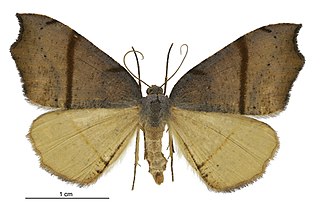
Sestra flexata, also known as the common fern looper, is a species of moth in the family Geometridae. This species is endemic to New Zealand.























